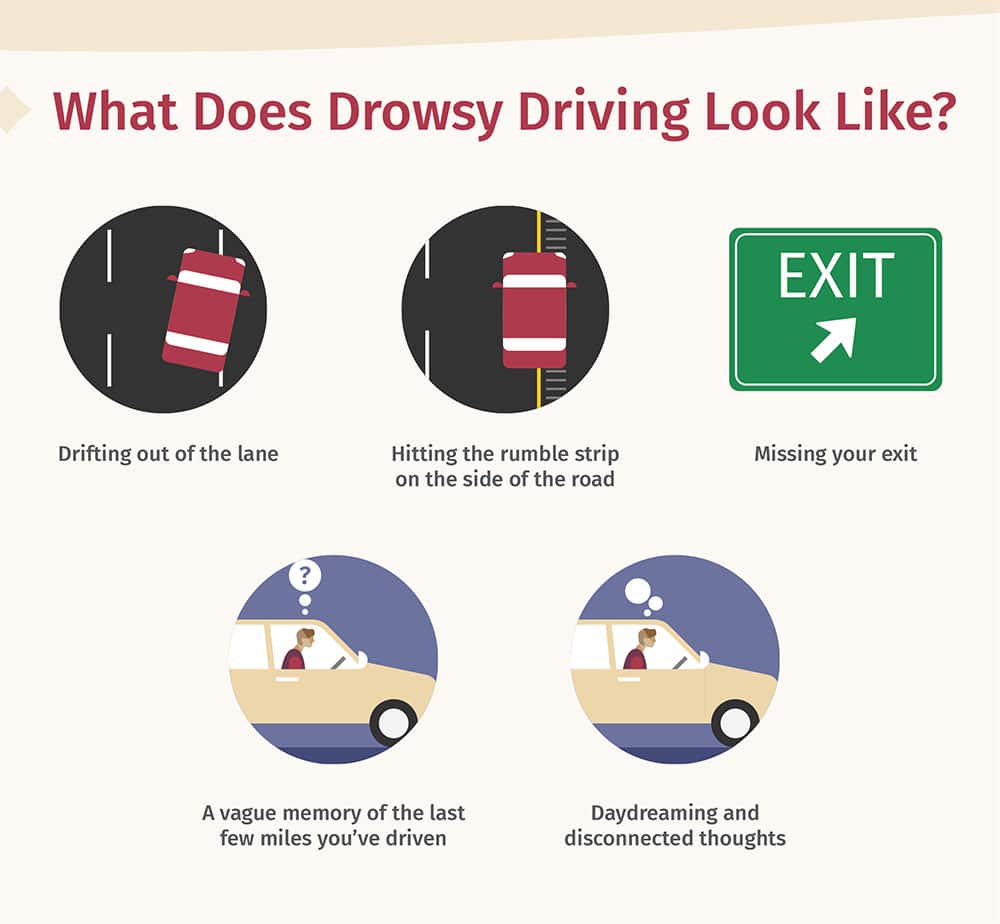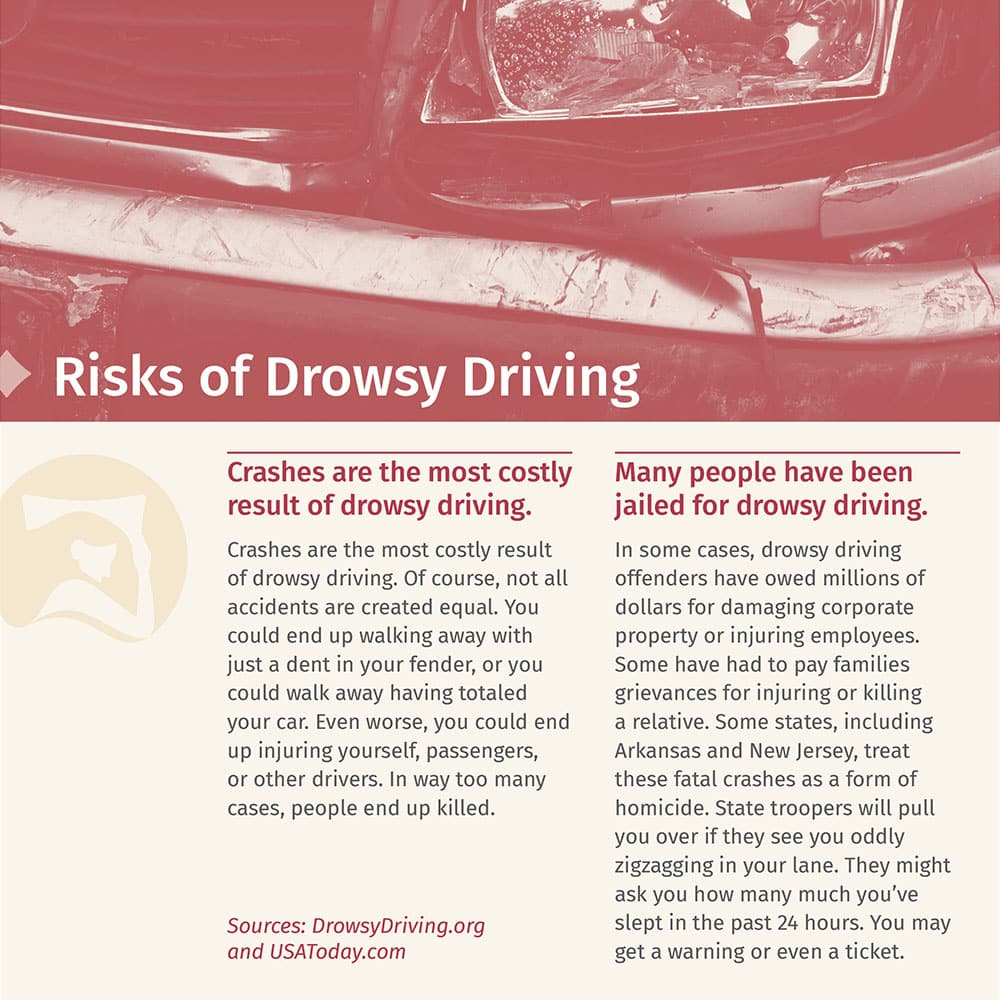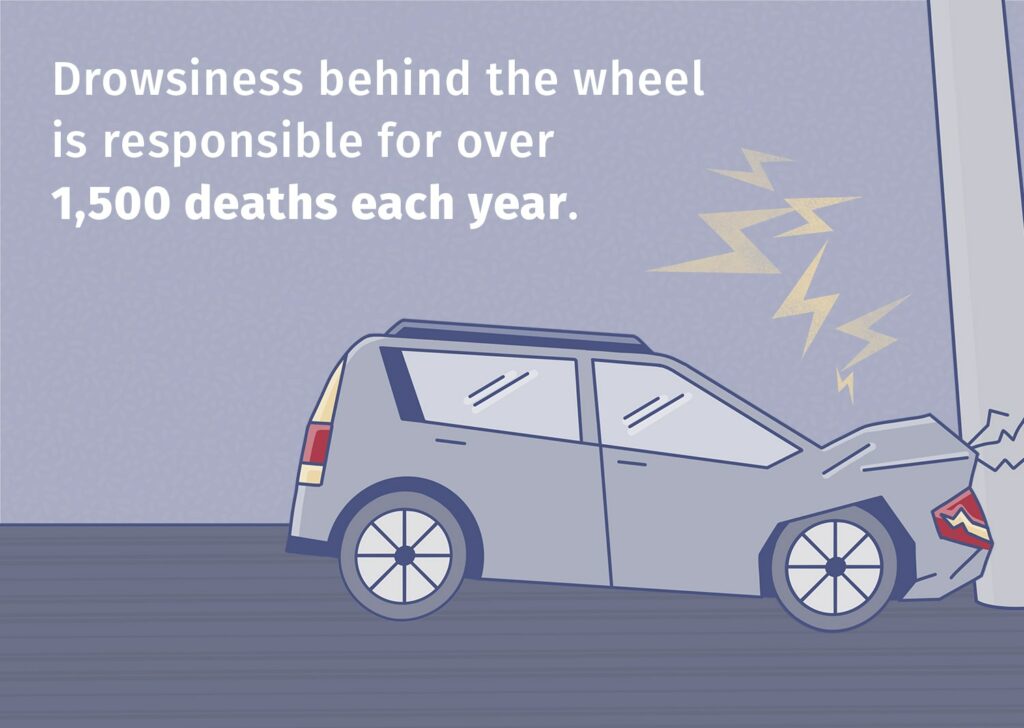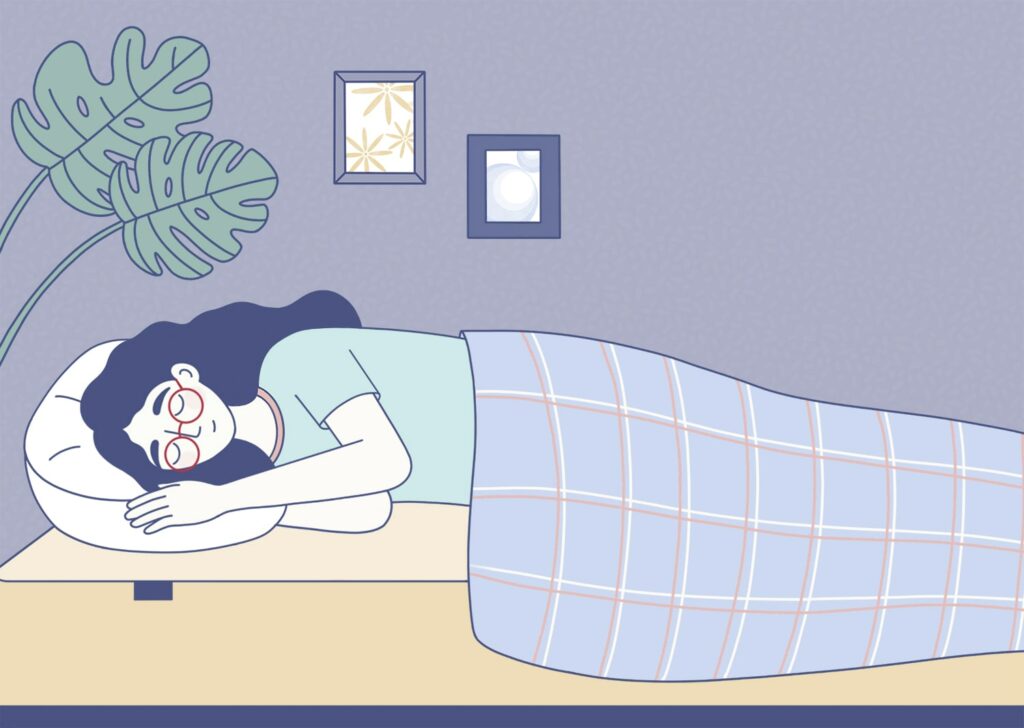“Driving while sleepy,” or drowsy driving, can be deadly. Drowsiness behind the wheel is responsible for over 1,500 deaths each year.
Drowsy driving is such a serious issue that many car manufacturers are developing technologies to help prevent these sorts of accidents from happening.
In 2017, Toyota launched Toyota Safety Sense, a set of safety features that now come standard on all new models. If the car senses abnormal steering wheel activity or sudden lane deviation, it will flash a coffee cup icon on the dashboard and set off a sound alarm. Companies including Audi, Mercedes, and Volvo also offer drowsiness detection systems that alert drivers when they are falling asleep.
These advancements are promising, but it’s still important to know how to prevent drowsiness from occurring and what to do when we are feeling sleepy as we drive.
Here’s everything you need to know about drowsy driving so you can keep yourself (and everyone else) safe on the road.
Jump To
What is Drowsy Driving? | What Does It Look Like? | Who Is Most Likely to Do It? | Risks | Prevention | Teens & Young Adults | What to Do If You’re Driving Drowsy | Conclusion | Resources
What is Drowsy Driving?
Drowsy driving isn’t just about falling asleep at the wheel.
According to the Centers for Disease Control and Prevention (CDC), drowsy driving is the “dangerous combination of driving and sleepiness or fatigue.” When drowsiness seeps into our consciousness, it can have the same effects that alcohol has on our brains. Drowsiness can:
- Divert a driver’s attention away from the road
- Slow reaction times, making it extremely dangerous when steering and/or braking
- Impair judgment and good decision-making ability
In the AAA Foundation for Traffic Safety’s 2020 report, 17.3% of respondents admit to having driven while being so tired they had a hard time keeping their eyes open at least once in the past 30 days. But the report also offers some hope, sharing that “Consistently over the past three years, significant reductions were found in self-reported engagement in drowsy driving.”
How Do You Identify Drowsy Driving?
It’s easy to write someone off for drunk driving because investigators can use breathalyzers, but there are no tests for sleepiness. Most cases of drowsy driving are self-reported, which is not the most reliable method of collecting information. Not everyone is willing to admit they were sleepy, and some people have trouble knowing if they were fatigued in the first place.
Scientists have developed a blood test that determines whether a person has skipped a night of rest. The researchers discovered that people who have not slept within the past 24 hours develop unique biomarkers in their blood that indicate a lack of sleep. It is possible that these types of blood tests could be used to identify cases of drowsy driving.
“The very existence of such biomarkers in the blood after only a period of 24-hour wakefulness shows the physiological impact a lack of sleep can have on our body,” study co-author Simon Archer, Professor of Molecular Biology of Sleep at the University of Surrey, told Science Daily. “Identifying these biomarkers is the first step to developing a test which can accurately calculate how much sleep an individual has had.”
What Does Drowsy Driving Look Like?
Even though drowsy driving can be difficult to measure, there are some clear warning signs that show a driver is not alert enough to be on the road:
- Drifting out of the lane
- Frequent blinking, yawning, or rubbing of the eyes
- A vague memory of the last few miles you’ve driven
- Missing your exit
- Irritability and restlessness
- Daydreaming and disconnected thoughts
- Hitting the rumble strip on the side of the road

It’s also important to identify situations where a driver has the potential to become a drowsy driver before anyone even turns on the ignition. Here are some classic situations in which drowsy driving is likely to occur:
- In the evening after a long day (or after a night of sleep deprivation). Most drowsy driving accidents occur at night when the body naturally wants to fall asleep. If someone is fatigued from a long day at work or has simply not gotten enough sleep on a comfortable mattress the night before, that person has a higher chance of dozing off during the drive.
- During long road trips. Drowsy driving may be most common at night, but it can happen at any time of day — especially during long road trips. Driving down the same empty road for hours on end can get monotonous after a while. If there are no other cars, pedestrians, or changing landscapes to look at, the mind does not have to work as hard to assess its surroundings. Soon your mind starts to wander and your alertness begins to drop. Additionally, sitting for long periods causes your blood flow to slow down. That will encourage the body go into energy conservation mode and can bring on the Zzzs.
- After consuming alcohol. Drivers also need to be aware of what they are putting into their bodies before they get in the car. Alcohol — even when consumed in small amounts — can be dangerous. You might not feel drunk after one beer at the bar, but alcohol coaxes the body to feel more relaxed or sedated. If you’re already a bit tired, having a drink can increase the urge to fall asleep.
- After taking certain medications. People who take certain medications have to be careful as well. Some drugs induce drowsiness and will put drivers at risk. For example, certain cold and allergy medications (such as NyQuil or Benadryl) can make you sleepy. Also be aware of certain painkillers, such as codeine or morphine, or anxiety meds such as Xanax or Valium.
If you ever find yourself in any of these situations before you step behind the wheel, it’s probably best that you let someone else take over for you or find some other way to avoid driving. That way, you and any fellow passengers can stay out of danger and keep the streets as safe as possible.
Who is Most Likely to Drive Drowsy?
While everyone has the capacity to doze off on the road, certain lifestyle factors and medical conditions can have a huge impact on a person’s alertness and increase their risk of driving while drowsy. These risk factors include:
- Shift work. This includes any work that takes place outside of the typical 9 to 5 schedule. It can include late night, early morning, or long rotational shifts. Any job that involves shift work can drastically affect a person’s natural circadian rhythms and increase sleep debt. As a result, work performance decreases and more errors can occur on the job or while driving home.
- Working as a commercial driver. Of all shift workers, commercial drivers are the most at risk since they often have to drive long hours on the interstate — sometimes up to 11 hours a day. In some cases, truck drivers end up pushing themselves through fatigue in order to meet company deadlines. Fatigue and long, monotonous stretches of road can both increase the risk of driving while drowsy.
- Sleep disorders. Those who suffer from sleep apnea or other sleep disorders such as narcolepsy and insomnia can be a danger to themselves and other drivers on the road, particularly when they drive after a night of insufficient sleep.
- Gender. Sleep-related crashes affect young men more than any other gender or age demographic in the U.S. Overall, men are twice as likely to fall asleep at the wheel than women.
- Age. Teenagers tend to be at risk because they have less experience driving and they biologically need more sleep than other age groups. Most experts suggest teens need more than nine hours of sleep per night, but oftentimes (with the stress of school and extracurricular activities) this age group sleeps less than eight hours a night. This helps explain why adults between the ages of 18 and 29 are 19% more likely to drive drowsy than people aged older. Less experienced drivers tend to underestimate the effects of fatigue and are more likely to drive when they are not fully awake.
Anyone can be guilty of drowsy driving, but if you fit into one of these demographics, it’s important to be aware of the increased risks. Awareness is the first step to making healthier decisions behind the wheel.
Sleep Apnea
A team of researchers from Brigham and Women’s Hospital investigated the relationship between car crashes and two potential contributing causes: not getting enough sleep or experiencing sleep apnea, a common condition wherein your breathing slows or stops during the night. This diminishes sleep quality and can cause daytime fatigue.
The researchers analyzed data collected from 1,745 men and 1,456 women between the ages of 40 and 89. They found that people with severe sleep apnea had a 123% increased risk of being in a motor vehicle crash.
“We found that chronically sleep-deprived individuals don’t perceive themselves as being excessively sleepy and thus don’t perceive themselves as impaired,” lead author Dr. Daniel J. Gottlieb said in a press release. “This resulted in an increased risk of motor vehicle crashes in sleep-deprived individuals.”
The researchers from this study believe that treating people for sleep apnea may decrease the likelihood that they get in a car crash—though the relationship between the two isn’t cause-and-effect.
Sleep Deprivation
Sleep deprivation is linked with a higher likelihood of being in (and being responsible for) a car crash, says a new study. These risks may increase when sleep deprivation is more severe.
The study, which was published in the journal SLEEP, found that people who slept for fewer than seven hours within the past 24 hours have a greater chance of being in and being responsible for car crashes. People who slept for fewer than four hours within the past 24 hours demonstrated an even higher likelihood of being culpable for a crash.
Sleep Issues For Rideshare Drivers
There are a couple of reasons why drowsiness is especially prevalent with rideshare drivers.
First, many rideshare drivers have another primary job. Because of this, they will often drive after already having completed a full day of work, mainly at night.
This means many rideshare drivers are cruising around in a sleep-deprived state and with disrupted circadian rhythms, which can lead to drowsy driving. While some companies do require rest periods after extended driving hours, this is sadly not the norm in the ridesharing industry.
Second, unlike taxi and bus services, there is little official regulation of ridesharing. While taxi and bus drivers are screened for possible sleep-related conditions such as obstructive sleep apnea, rideshare drivers are not.
Risks Associated With Drowsy Driving
If you ever catch yourself feeling a bit groggy at the wheel, you might feel tempted to keep going and just rest when you get to your destination. But be aware that you are taking on immense risks when you’re not driving at 100 percent.

Bottom line? Drowsy driving has some scary consequences. This helps explain why state governments are doing their best to prevent these accidents from happening. Some highway administrations have installed signs saying, “Driving drowsy causes crashes” or “Drowsy? Crash on a Couch Not a Road”. Governments have also invested in building more rest stop areas.
But despite all the measures that are being taken, state officials have found it very difficult to really crack down on “snoozing and cruising” at large.
Very few police officers are formally trained to detect a fatigued driver. There’s no device that can measure sleepiness like a breathalyzer can analyze someone’s drunkenness. And oftentimes when someone hears the cop siren and sees those flashing lights, the adrenaline kicks in and reawakens the person before the police arrive at their car door.
In order for someone to prosecute or make a case against a drowsy driver, the driver has to be willing to admit that they were tired. Not everyone can or will give this information, especially if it means they’ll be in more trouble than they were to begin with.
We spoke with Jonathan Russell, personal injury lawyer and shareholder of Drake, Hileman & Davis, about drowsy driving cases. Russell says he’s handled several cases where the other driver has simply fallen asleep, but “it is sometimes difficult to tell if poor judgement is caused by lack of sleep, or just a poor decision.”
When asked about how the damage compares in drowsy driving accidents to others, Russell advised “Damage is usually more severe when the defendant drifts into the oncoming lane causing a head-on collision.” He also explained how these types of cases differ from other accidents.
“It can give a reason for the jury to be more upset with a defendant, knowing that the collision could have been avoided. But it can also create some sympathy. I had a situation where a defendant was working multiple jobs and wasn’t getting enough sleep. Not that excessive work would excuse negligent behavior, but it is viewed differently than someone who passes out due to drugs or alcohol.”
Nonetheless, Russell affirms there are many dangers of driving while tired and reminds us that “you can’t fight sleep – the only cure for lack of sleep is sleep itself.”
How To Prevent Drowsy Driving
So what can we do to prevent ourselves from getting into any trouble at all?
Before anyone hops into the driver’s seat, there are a few things you can do to make your trip as safe as possible:
- Do not drink alcohol before driving. Alcohol increases drowsiness.
- Make a habit of getting 7-8 hours of sleep a night. With a full night’s rest, your mind will be fully alert during normal waking hours. According to the NHTSA, this is the best preventative measure you can take.
- Do not take drugs that induce drowsiness. Read the labels on your medication to make sure there are no risky side effects.
- Get a good night’s rest before long road trips or make sure to travel with a driving buddy. When you get a little tired, it’s good to switch with someone who is more awake.
- If you have a sleep disorder, talk to your physician for treatment and to determine whether you’re fit to drive.
How Teenagers And Young Adults Can Avoid Drowsy Driving
As noted above, teenagers and young adults may be particularly susceptible to drowsy driving for a number of reasons: They have higher sleep needs but are often running a sleep deficit, and they have less experience behind the wheel. According to the National Safety Council, here are some tips that can help teenagers and young adults limit their risk of driving while drowsy:
- Practice healthy sleeping habits.
- Know the risks of drowsy driving and how it can be just as dangerous as drunk driving.
- Call for a ride if you think you are too tired to drive.
- Keep tabs on your schedule. Between school and other activities, teenagers and young adults can be very busy. It’s important to make sure you aren’t scheduling a lot of early morning or late night activities to avoid putting yourself in situations where you might be too exhausted to drive on your own.
How to Respond if You Catch Yourself (or Someone Else) Driving Drowsy
While the preceding precautionary tips will put you in the best position to drive safely, there’s a chance you could still get a little groggy on the road. If you ever catch yourself drowsy driving, consider taking one or several of the following precautions:
- Try drinking caffeine. If you’re feeling sleepy, energy drinks and coffee can work as a quick pick-me-up, but they aren’t long-lasting cures for drowsy driving. The effects of caffeine only last for a short time, and if you’re really exhausted, you can still experience “micro-sleeps” where you lose consciousness for four to five seconds at a time. If you have an energy drink or soda, watch out for the ones that contain a lot of sugar. Sugar highs might give you a temporary rush, but they are paired with a sudden crash in stamina, alertness, and overall concentration.
- Pull over and take a nap. This is the most recommended solution if you catch yourself falling asleep. As soon as you feel yourself nodding off, find the closest rest stop and take a 20- to 30-minute catnap before you continue driving. Studies have shown that sleeping for 26 minutes can improve performance by 34 percent and alertness by 54 percent. As with caffeine, though, the positive effects of napping are temporary.
If you’re ever out on the road and you suspect someone else is drowsy driving, there are a few things you can do to (hopefully!) prevent a serious accident from happening:
- Drive to a safe place. It’s important that you get out of harm’s way before you try to assist the situation.
- Call the police. Dial 911 and report the driver by describing the car, the direction it’s traveling, and the license plate number. Police will investigate the situation and get the driver to safety.
There’s only so much you can do to keep you or anyone else awake while they are driving. If you find yourself feeling sleepy behind the wheel, don’t push through. Get a hotel room and sleep on a nice mattress and pillow instead. And if you see another driver dozing off on the road, pull over and call for help.
Conclusion
Drowsy driving is a serious problem and needs to be treated as such. It’s so easy for us to fall into our normal habits of working through fatigue and lack of sleep, but that mindset is dangerous — if not fatal — once we get behind the wheel. It’s killed hundreds and injured thousands of people every single year.
Driving while sleepy is just like driving while intoxicated. Fatigue impairs your concentration, reaction time, and judgement, causing you to do all sorts of things on the road: drifting, swerving, sudden speed changes, and missing exits. Reckless driving can get you in a devastating accident, which can put you in jail or serious debt. So if you’re feeling the slightest bit tired ahead of your trip, make sure you are taking the proper precautions before you put the keys into the ignition.
While car companies are doing their best to come up with technologies that keep us from driving drowsy, it’s still up to us to make sure we are fit enough to be on the road. Remember, if you ever feel your eyes start to droop on the ride: Stop, pull over, and get some shuteye. You and everyone else on the road will be safer for it.
Additional Resources
For more information on drowsy driving and how to prevent it, check out these links:
- Caution: Some Over-the-Counter Medicines May Affect Your Driving
- NHTSA Drowsy Driving Research and Program Plan
- Educating Youth About Drowsy Driving
- Quick Sleep Tips for Truck Drivers
- National Sleep Foundation Drowsy Driving Prevention
- Safety Guide for Responsible Young Drivers

